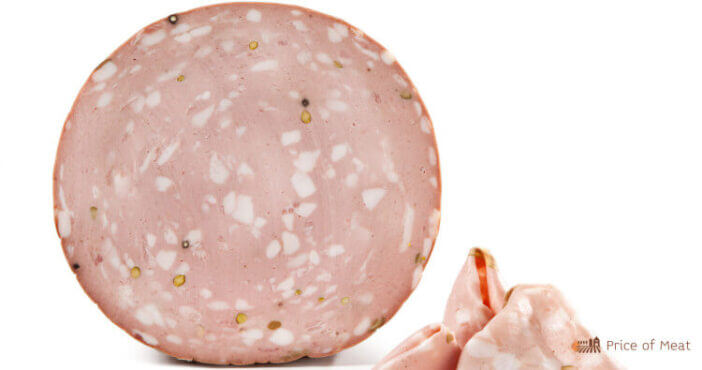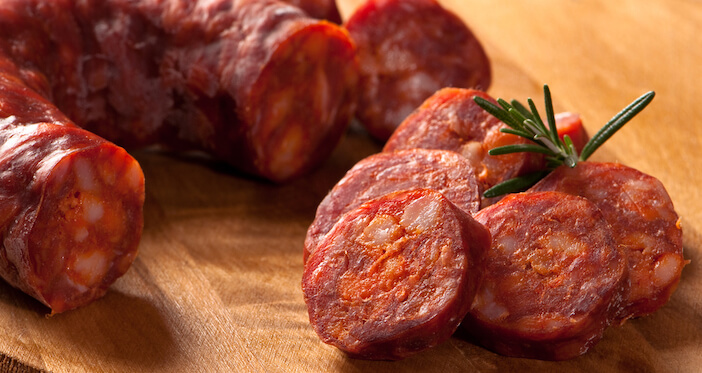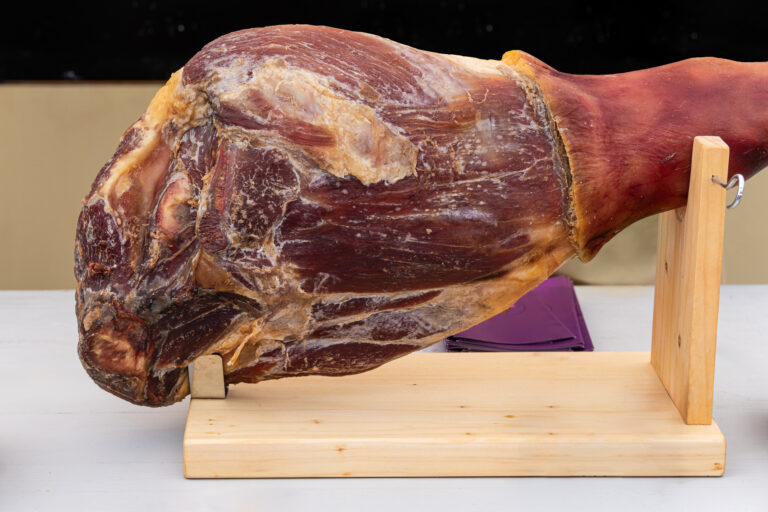12 Cured Meats You Need for the Best Snack Platters
Popular cured meats like soppressata, mortadella, Spanish chorizo, and prosciutto offer unique flavors and textures, perfect for charcuterie boards or snacking.

Snack platters have come back in a big way. Whether you call them charcuterie boards or a light snack, the combination of meat, cheese, fruit, and nuts is as classic as it is tasty. Depending on your taste, you might base your snack platter on cheese or fruit, but we know the true star is the meat.
We’ve gathered a list of twelve tasty cured meats that you’ll need to pick up, and we’ll also answer some frequent questions.
Disclosure: As an Amazon Associate, this site earns from qualifying purchases. Thank you!
Soppressata

Soppressata is an Italian cured salami native to southern Italy. The meat combines lean and fatty cuts of pork shoulder and ham. Before curing, they season the meat with crushed and dried chili peppers, black peppercorns, and hearty red wine. The meat is slipped into sausage casings and left to cure until perfect.
The taste is spicy and savory with a powerful kick and subtle earthy undertones.
Mortadella

Mortadella is a typical Italian lunch meat and is often used the same way Americans use bologna. The meat consists of cured pork, pork fat, sliced pistachios, and black pepper. The cured meat tastes delicious on its own, thanks to its high-fat content.
Unlike bologna, mortadella has a rich flavor that makes it an excellent snack platter choice. Some varieties include small slices of olive in the meat.
Spanish Chorizo

There are two primary varieties of chorizo: Spanish and Mexican. Mexican chorizo is ideal for chili, burritos, or served with rice, but Spanish chorizo is ideal for charcuterie platters. Spanish chorizo is fermented and cured, stuffed with dried red peppers (paprika).
Spanish chorizo has a smoky flavor, making it ideal for a thinly-sliced snack. It’s hard to stop snacking when paired with a complementary Spanish cheese like manchego.
Cappacoullo

Thanks to the hit TV show “The Sopranos,” Capocollo is well-known in America as “gabagool.” This Italian meat consists of pork shoulder, which is dry-cured and seasoned with red wine, garlic, paprika, fennel, and black pepper. Although the meat is heavily seasoned, the taste isn’t overwhelming.
Capocollo is one of the most popular cured meats in Italy, where it’s commonly added to charcuterie boards, sandwiches, and salads.
Jamón Ibérico

Jamón Ibérico is one of the most famous cured meats in the world and, consequently, a costly cut of meat. The meat comes from Black Iberian pigs raised in Portugal and Spain. The pigs eat acorns and chestnuts from local groves, so the meat has a nutty and earthy flavor that is highly praised.
The fat content is also high, so the meat has an almost buttery texture.
Saucisson

Most cured meats are from Italy, but Saucisson is an example of French cured meat. Saucisson is a type of salami meat that mixes lean ground pork with pork fat, white wine, and garlic.
One of the best things about saucisson is the variety that’s available, as you can find versions of the meat that lean towards spicy, savory, or sweet, depending on your taste.
Prosciutto

Prosciutto is a broad category in Italy (where the word translates to simply “ham”), but in America, prosciutto typically means prosciutto crudo, a dry-aged, uncooked cured meat. The meat comes from the pig leg and is sliced incredibly thin. You can see the white lines of delicious pork fat in the well-sliced prosciutto.
Prosciutto has a slightly sweeter flavor than most cured meat, which sets it apart on a snack platter.
Finocchiona

Finocchiona is one of the oldest cured meats, hailing from Tuscany, Italy, in the middle ages. Back in the day, black peppercorns were an expensive and hard-to-find spice, so fennel was used instead of black pepper for finocchiona. The result is a salami that carries a slight licorice or anise flavor, which is surprisingly delightful.
Finocchiona has a slightly herby taste that many cured meats don’t.
Calabrese Salami

Calabrese salami is a staple of southern Italy, which is well-known for its bold and savory flavors. The salami uses pork shoulder, hard pork fat, red wine, crushed red pepper, and paprika. The meat is coarsely ground, so you can clearly see the separation of meats in a single slice.
Calabrese salami is an excellent option for people who enjoy extra spice in their lives.
Pancetta

Pancetta is often mistaken for bacon at first glance. Both cuts of meat use pork belly, but while bacon needs to cook, the curing process of pancetta means you can eat it straight without needing a pan.
Pancetta is cured and seasoned with garlic and pepper. Since the meat uses pork belly, pancetta is one of the fattiest cured meats and has a very tender texture.
Speck

Speck is often overlooked when it comes to meat snacking and charcuterie boards. The cured meat consists of pork leg, which resembles prosciutto, though the speck is lightly smoked. This meat comes from northern Italy and comes from the mountainous region.
Speck is held to a high standard, so only authorized products can advertise themselves as “true speck.” The flavor is light with a slight herbal undertone of bay leaf.
Genoa Salami

Most people agree that Genoa salami originated in Genoa, Italy, a famous area well-known as a central hub for the Mediterranean throughout history. This cured meat is one of the more common options, and you’ll likely find this salami in any grocery store.
However, common doesn’t mean boring, as Genoa salami is flavored with black peppercorns, garlic, and red wine. The taste is fairly bold, with a subtle hint of sweetness. The texture is smooth and slightly soft, with a buttery feeling from the fat content.
What are examples of cured meats?
Curing is the process of adding salt to meat or fish to preserve and flavor the item. Some of the most popular and widespread examples of cured meats include pepperoni, salami, bacon, prosciutto, and mortadella.
Cured meats are easily recognizable because of their salty, aged flavor and use as a popular snacking meat.
How many types of cured meat are there?
Curing meat is thousands of years old, so the number of cured meats may be as high as the different types of meat worldwide. Cured meat can be as simple as jerky or as delicate and expensive as jamón ibérico.
Since the practice is so widespread, there are likely around 130+ types of cured meat.
Are sausages cured meat?
Not all sausages are cured, but many types of sausages are excellent examples of cured meat. All sausages are considered either fresh or cured. Cured sausages are preserved and flavored with a mix of salt, nitrates, and nitrites. Fresh sausages are any sausages that aren’t cured.
Cured sausages often have a smoky flavor and last longer than fresh sausages.
What are naturally cured meats?
The curing process utilizes nitrites and nitrates to preserve and flavor the meat. Some people are concerned about the excess consumption of nitrites and nitrates, so naturally cured meats use natural nitrites and nitrates (like celery juice) instead of direct chemicals like sodium nitrite.
Naturally cured meats have lower levels of nitrites and nitrates than traditionally-cured meats.






